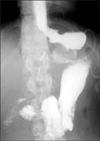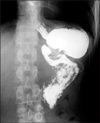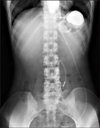Abstract
Laparoscopic adjustable gastric banding (LAGB) has proved to be safe and effective, worldwide. The perigastric technique was once the most frequent method of band placement, but posterior prolapse was a problem. The introduction of the pars flaccida technique has considerably reduced the incidence of this complication, and, currently, this technique is the most utilized method and recommended by most bariatric surgeons. However, LAGB with pars flaccida technique has rare complications such as band slippage and gastric pouch dilatation in 2~5% of patients. We have experienced 2 band replacement cases for band slippage and pouch dilatation each happening about 1 and 2 years after LAGB.
Figures and Tables
References
1. Manganiello M, Sarker S, Tempel M, Shayani V. Management of slipped adjustable gastric bands. Surg Obes Relat Dis. 2008. 4:534–538.
2. Chevallier JM, Zinzindohoue F, Douard R, Blanche JP, Berta JL, Altman JJ, et al. Complications after laparoscopic adjustable gastric banding for morbid obesity: experience with 1,000 patients over 7 years. Obes Surg. 2004. 14:407–414.
3. Ponce J, Fromm R, Paynter S. Outcomes after laparoscopic adjustable gastric band repositioning for slippage or pouch dilation. Surg Obes Relat Dis. 2006. 2:627–631.
4. Foletto M, Bernante P, Busetto L, Pomerri F, Vecchiato G, Prevedello L, et al. Laparoscopic gastric rebanding for slippage with pouch dilation: results on 29 consecutive patients. Obes Surg. 2008. 18:1099–1103.
5. Kim E, Kim D, Lee S, Lee H. Minimal-scar laparoscopic adjustable gastric banding (LAGB). Obes Surg. 2009. 19:500–503.
6. Kirshtein B, Avinoach E, Mizrahi S, Lantsberg L. Presentation and management of port disconnection after laparoscopic adjustable gastric banding. Surg Endosc. 2009. 23:272–275.
7. Shipkov CD, Uchikov AP, Uchikova EH. Small bowel obstruction by the silicone tube of the gastric band. Obes Surg. 2004. 14:1280–1282.
8. Iannelli A, Facchiano E, Sejor E, Baque P, Piche T, Gugenheim J. Gastric necrosis: a rare complication of gastric banding. Obes Surg. 2005. 15:1211–1214.
9. Keidar A, Szold A, Carmon E, Blanc A, Abu-Abeid S. Band slippage after laparoscopic adjustable gastric banding: etiology and treatment. Surg Endosc. 2005. 19:262–267.
10. Thornton CM, Rozen WM, So D, Kaplan ED, Wilkinson S. Reducing band slippage in laparoscopic adjustable gastric banding: the mesh plication pars flaccida technique. Obes Surg. 2009. 19:1702–1706.




 PDF
PDF ePub
ePub Citation
Citation Print
Print






 XML Download
XML Download